Heavy rainfall in Western Europe in July, which led to severe and fatal flooding, was made nine times more likely by climate change, a new study claims.
Almost 40 researchers from six European countries and the US calculated that downpours of the kind that caused last month’s floods are now 1.2 to nine times more likely – and this will increase further if the planet continues to heat up.
Flooding from July 14 to 15 this year resulted in at least 184 fatalities in Germany and 38 in Belgium and catastrophic damage to infrastructure, including houses, motorways, railway lines, bridges and key income sources.
Swollen streams turned into raging rivers, sweeping away houses, roads and bridges, and causing billions of euros in damage.
Road closures left some places inaccessible for days, cutting off some villages from evacuation routes and emergency response efforts.
But the study suggests global warming makes the kind of extreme rainfall that caused the deadly flash flooding more likely.
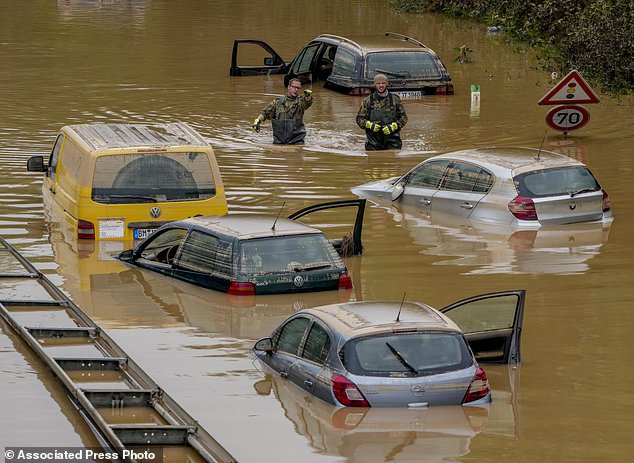
People check for victims in flooded cars on a road in Erftstadt, Germany on July 17, following heavy rainfall that broke the banks of the Erft river, causing massive damage
MAIN FINDINGS
– In the current climate, for a given location within this larger region, experts expect one such event every 400 years on average.
– Climate change increased the intensity of the maximum one-day rainfall event in the summer season in this large region by about 3 to 19 per cent compared to a global climate 2.2°F cooler than today.
– The likelihood of such an event to occur today compared to a 2.2°F cooler climate has increased by a factor between 1.2 and 9 for the one-day event in the region.
– In a climate 3.6ºF warmer than in preindustrial times models suggest that the intensity of a 1-day event would increase by a further 0.8-6 per cent and the likelihood by a factor of 1.2 to 1.4.
Advertisement
Extreme rainfall occurred in Germany, Belgium, Luxembourg and neighbouring countries from July 12 to 15, leading to severe flooding, particularly in North Rhine-Westphalia and Rhineland-Palatinate in Germany and along the river Meuse and some of its tributaries in Belgium and the Netherlands.
In the current climate, for a given location within the larger Western European region, one such event will happen every 400 years on average, say the experts, who form part of the University of Oxford-backed World Weather Attribution group.
Frank Kreienkamp of Germany’s nation weather service DWD, one of the authors on the study, said the findings supported forecasts in a recent UN climate report.
‘Humans are clearly changing and warming up the Earth’s climate,’ he said. ‘And with this warming we are also seeing a change in weather extremes.’
The authors said the damage and loss of life last month highlight how nations need to do more to curb greenhouse gas emissions and prepare for such disasters.
‘These floods have shown us that even developed countries are not safe from severe impacts of extreme weather that we have seen,’ said Friederike Otto, associate director of the Environmental Change Institute at Oxford University.
‘This is an urgent global challenge and we need to step up to it. The science is clear and has been for years.’
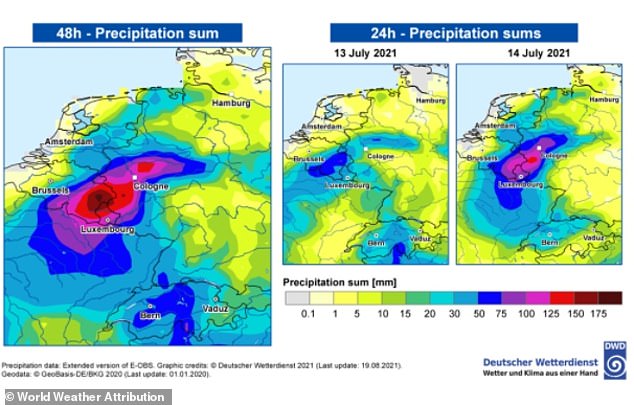
Left, precipitation accumulated over two days (July 13 and 14). Right, precipitation accumulated over 24 hours for each of the individual days
For the study, researchers looked at two small regions where the recent flooding was most severe – the the Ahr and Erft rivers in Germany and on the Meuse in Belgium.
In the Ahr-Erft region, 3.66 inches of rain fell in a day, while in the Meuse region, more than four inches fell over two days.
They used historical records and computer simulations to examine how temperatures affected rainfall from the late 19th century to the present.
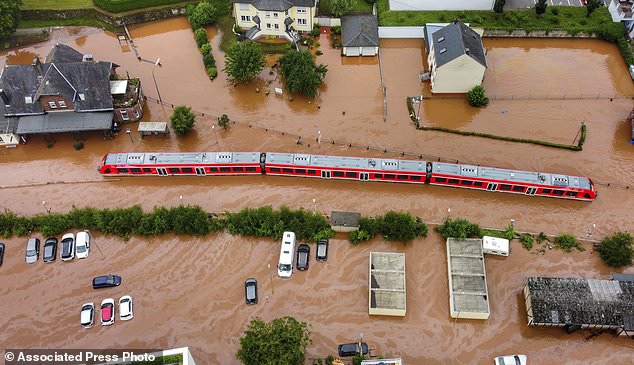
A regional train in the flood waters at the local station in Kordel, Germany on July 15, after it was flooded by the high waters of the Kyll river
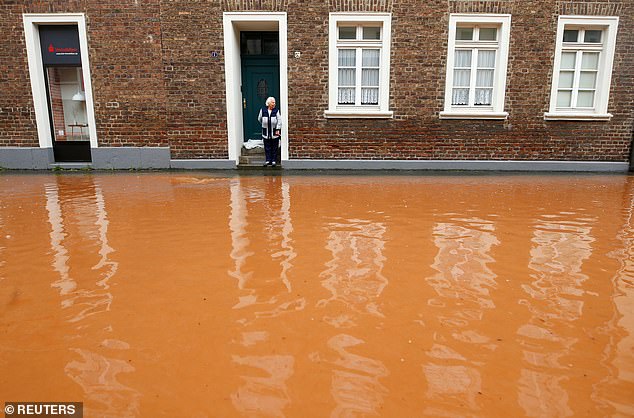
A street is flooded with dirty water following heavy rainfalls in Erftstadt, Germany, as seen on July 16 this year
While the study hasn’t been assessed by independent scientists yet, its authors used widely accepted methods to conduct rapid assessments of specific weather events such as floods, droughts and heat waves.
It found that across a large strip of western Europe – stretching from the Netherlands to Switzerland – the amount of rainfall in a single day increased by 3 per cent to 19 per cent over the period, during which global temperatures increased by 2.2°F (1.2°C).
For every 1.8°F (1°C) the planet warms, the air can absorb seven per cent more water, and when that water is released, it causes more extreme rainfall.
Flooding was caused by very heavy rainfall over a period of one to two days, as well as wet conditions already before the event, as soils were already saturated.
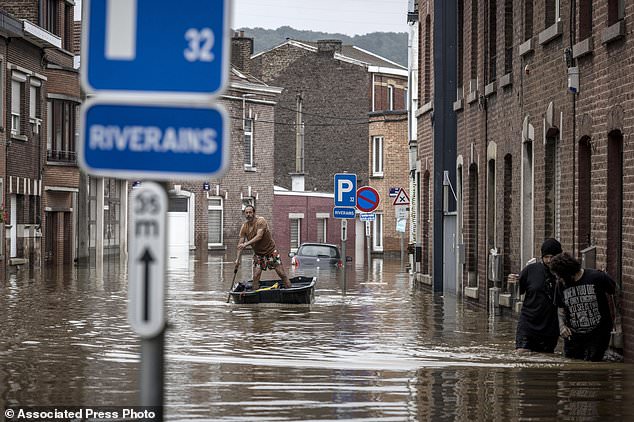
A man rows a boat down a residential street after flooding in Angleur, Province of Liege, Belgium in July 16

Photo taken on July 17 shows river and houses severely damaged after flooding in Pepinster, Belgium
The team also predicted what would happen if humanity failed to achieve the primary aim of the Paris Agreement, signed in 2016, which aims to keep the global average temperature rise to below 3.6ºF (2°C) compared to pre-industrial levels.
In a climate 3.6ºF warmer than in preindustrial times, models suggest the intensity of a one-day event would increase by a further 0.8 to 6 per cent, the experts found, and the likelihood of such an event by a factor of 1.2 to 1.4.
In summary, the researchers say human-induced climate change ‘has increased the likelihood and intensity of such an event to occur and these changes will continue in a rapidly warming climate’.
‘Given the rarity of the event it is clear this is a very extreme event that is reasonably likely to cause negative impacts,’ they say.
‘However, especially given events like this will occur more frequently in the future, examining how vulnerability and exposure can be reduced becomes critical to reducing future impacts.’
THE PARIS AGREEMENT: A GLOBAL ACCORD TO LIMIT TEMPERATURE RISES THROUGH CARBON EMISSION REDUCTION TARGETS
The Paris Agreement, which was first signed in 2015, is an international agreement to control and limit climate change.
It hopes to hold the increase in the global average temperature to below 2°C (3.6ºF) ‘and to pursue efforts to limit the temperature increase to 1.5°C (2.7°F)’.
It seems the more ambitious goal of restricting global warming to 1.5°C (2.7°F) may be more important than ever, according to previous research which claims 25 per cent of the world could see a significant increase in drier conditions.
In June 2017, President Trump announced his intention for the US, the second largest producer of greenhouse gases in the world, to withdraw from the agreement.
The Paris Agreement on Climate Change has four main goals with regards to reducing emissions:
1) A long-term goal of keeping the increase in global average temperature to well below 2°C above pre-industrial levels
2) To aim to limit the increase to 1.5°C, since this would significantly reduce risks and the impacts of climate change
3) Goverments agreed on the need for global emissions to peak as soon as possible, recognising that this will take longer for developing countries
4) To undertake rapid reductions thereafter in accordance with the best available science
Source: European Commission
Advertisement
Source link : https://www.dailymail.co.uk/sciencetech/article-9921613/Climate-change-Europes-fatal-floods-likely-study-says.html












